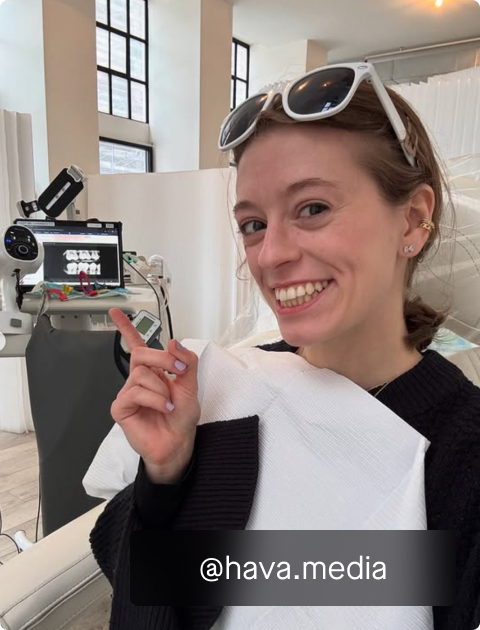White stains on teeth? Here's what to do

Yellow teeth and dark stains might be the first thing to come to mind when you think of teeth discoloration. But you might find yourself with the opposite problem: white stains on your teeth. We'll go through what causes those white stains, what that means for your teeth and oral health, and what you can do to help make your smile more uniform in shade.
White marks on teeth, what are they?
Those white marks on your teeth are called "white spot lesions." Yes, lesions. Those white spots are a sign of early enamel decay. But don't fret! Like we said, they are a sign of EARLY decay, which means you can stop it, treat it, and reverse it if you take the right steps.
Let's geek out on what's happening - or if you don't want to dive deep, skip to the next section. Those white spot lesions are enamel experiencing decalificiation. If particular parts of your enamel are repeatedly exposed to acids from bacteria (and not frequently cleaned of that bacteria through your daily hygiene routine and routine dentist visits), the enamel in that area will demineralize, leaving a chalky white spot.
So the enamel is decalcified … but why is it white? We often associate tooth decay with darker discoloration, but in the case of white spot lesions the white color is a signal something has gone wrong. "White spot lesions reflect light differently than regular enamel, which is what makes them look white," explains Dr. Kevin Walker, DDS. "Preventing white spot lesions is always a challenge for patients who are going through traditional braces - it all comes down to maintaining excellent oral hygiene."
Braces are the best known cause for white spot lesions, but it's not the only cause.
White spots on teeth from braces and other things
The top reasons why white spot lesions form on your teeth are:
- Demineralization - when your teeth accumulate bacterial plaque
- Fluorosis - when your enamel experience overexposure to fluoride
- Enamel hypoplasia - when your enamel is just naturally thin
- Diet - low calcium diets in particular
- Poor oral hygiene - bacteria accumulates on your teeth which can then lead to demineralization
If you have white spot lesions after having braces, your teeth suffer from demineralization. Likely you kept up your oral hygiene routine, but the small groves and spaces of the brackets and wires make for great hiding places for bacteria, even if you brush regularly. Your braces probably accumulated extra bacteria that led to long-term exposure of acids on specific spots of your teeth.
If you didn't have braces but have white spots, your lesions might be caused by fluorosis or enamel hypoplasia.
Fluoride is important for forming and maintaining strong enamel. But like many things in life, balance is just as important when it comes to fluoride. If you ingest too much fluoride while your adult teeth are still forming, you can get fluorosis. If your white spot lesions have been around since your adult teeth first came out, there's a good chance those white spots were caused by fluorosis.
In some cases, white sports come from enamel hypoplasia - a condition where the enamel is thinner than normal. Enamel hypoplasia can be genetic or be the cause of mineral loss in teeth from nutritional deficiencies.
Teeth whitening for white spots
If you have white spot lesions and tried to whiten your teeth, you might have noticed that those white spots became … WHITER? This sucks because, even though the rest of your tooth whitened, the brighter white spot may make the rest of your tooth look less bright by comparison.
What to do? First, you'll want to make sure you're doing everything you can to keep those white spot lesions from getting worse.
"If you have white spot lesions, there are two steps to incorporate in your hygiene routine to prevent them from getting worse, or getting more white spots," shares Wally hygienist, Iman Zayed, RDH. "First you'll want to focus on minimizing bacteria in your oral environment, and keeping the pH as neutral as possible. Second, ensure you're remineralizing with the proper products at home and in-office. Your dentist can offer things like fluoride treatments to aid the remineralization process."
While there there is disagreement among the best way to remineralize (fluoride? nano-hydroxyapitite?) the dental community does agree that no matter how you do it, remineralization for your teeth is critical for long term tooth health.
To remove white spots on teeth, here's what you can do
Addressing white spot lesions isn't as simple as switching your toothpaste or toothbrush. It's often a multi-step process where your dentist will use incrementally stronger approaches to eliminate those pesky white spots.
Topical fluoride application is usually the first step to get rid of white spot lesions. Highly concentrated fluoride is applied to the white spots so the tooth can absorb the minerals. Sometimes your dentist might do a light etching of the area before putting on the concentrated fluoride to make it easier for your tooth to absorb the minerals.
In some cases, your dentist might give you an application of casein phosphopeptide-amorf calcium phosphate. Quite a mouthful - but what is CCP-ACP? Well, it helps increase calcium and phosphate levels and increase the pH of your oral environment. The result is stopping demineralization and increases remineralization.
Talking with your dentist (or dental care team) is the best way to start the conversation. If you have white spots and want to remove them, text our Care Team at 833-929-2559.
Check out our complete guide on teeth discoloration, "White spots on teeth and other discoloration" for everything you need to keep your teeth looking evenly bright.









